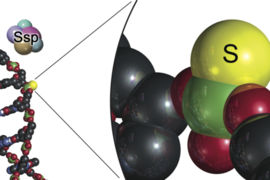For the past two and a half years, graduate student Tong Zhang has been figuring out how bacteria protect themselves against phages — the viruses that infect them. All the while, doing so as a student far from her hometown of Beijing, China.
Phages and bacteria are in a constant arms race, which those in the field call the Red Queen Conflict: Alice in Wonderland running to stay in place, the queen making chase. Both the infector and the infected are constantly forced to adapt — the host and the parasite persistently co-evolving.
Perhaps the best-known anti-phage defense systems are called restriction modification systems, and much of the influential work on those systems was done by Salvador Luria, the longtime MIT professor and founding director of what is now called the Koch Institute for Integrative Cancer Research. Those anti-phage defense systems can distinguish self DNA from foreign DNA; they are always active, in surveillance mode, ignoring the host DNA but on the hunt for foreign DNA to slice up to protect the host.
Other anti-phage systems, however, require activation. Although researchers have characterized systems that protect bacteria from phage, many questions remain about how those systems become activated during infection.
Unlocking phage science
In an open-access paper published last year, Zhang, along with collaborators, found that during infection, the capsid protein that coats the outside of the phage directly triggers activation of a toxin-antitoxin system called CapRel, where the N-terminus of the protein is the toxin and the C-terminus is the antitoxin; the C-terminus works as both infection sensor and inhibitor of the toxic N-terminus. The capsid protein of some phages infecting Escherichia coli, the bacteria studied for the paper, will bind to the C-terminal domain, which triggers activation of the toxic N-terminus defense system to restrict infection by blocking phage replication.
“The capsid is essential for the phage and is the most abundant thing in the phage.” Zhang says. “The bacteria are sensing something that the phage cannot just get rid of and still be happy, so this really limits the possibility that the phage can overcome this defense system.”
Before Tong’s paper, it was unclear that phage proteins could directly activate this defense system.
Although the details and molecules are different for different immune systems, the concept of sensing foreign invaders and responding to infection is conserved across all domains of life.
“It’s a testament to how hard she works, how smart she is, and how dedicated she is, that this project resulted in a paper in just two years — and started during a pandemic,” Laub says.
From Beijing to MIT
Zhang has thought biology was “cool” since long before she arrived at MIT. She hails from Beijing and was an undergraduate at the University of California at Berkeley, where her mentor gave her the perfect mix of guidance and independence.
“I think that experience made me realize that trying to figure out a problem is like solving a puzzle,” she says. “What I’m interested in is understanding mechanisms, the details of how different systems work. In my current research, there are a lot of open questions like that, which is really exciting.”
Laub says Zhang was the driving force behind the project, but collaborations also helped move the project along.
Although the pandemic posed a lot of challenges for research, it also changed the scales of distance: certain things work well in a virtual format. Laub was able to participate in a thesis defense abroad from the comfort of his desk in Cambridge, for example, and Zhang’s project came about in part because Laub served as an outside examiner for a lab in Sweden that had been studying CapRel.
But some things just don’t work on Zoom — like going home.
“There have been some unique challenges for Tong — and for all of our international students. They’re a long way from home, a long way from family,” Laub says. “The courage and the tenacity that it takes to not only do this work but to thrive and to succeed the way she has is remarkable.”
Zhang, like many international students pursuing education in the United States, has not been home in more than three years; in contrast, as an undergraduate, she went home for extended periods at least twice a year.
“I think that’s the most challenging part,” she says of her time at MIT.
She arrived in the United States to attend UC Berkeley having never visited the campus before. Zhang, used to sitting in the same classroom with the same group of people all day, was surprised to find that not only did she have the flexibility to pick out her course schedule, she also had to go to different places to attend classes, each with their own group of people.
“I’m really glad I went to UC Berkeley. There were a ton of opportunities and the science there was amazing. Obviously there were difficulties navigating a huge university and overcoming language barriers, but I think that also trained me to be more proactive in finding resources, finding help, looking for opportunities, and working to get them,” she says.
Laub says she’s just the type of student that MIT’s graduate programs are a good fit for.
“Our graduate program attracts people like Tong who are super rigorous scientists that really want to push that deep mechanistic, incisive understanding of things.”
Zhang is currently hard at work on her next project with “cool data” already in hand, Laub says.











